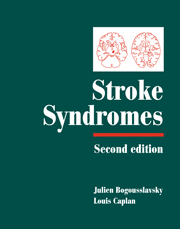Book contents
- Frontmatter
- Contents
- List of contributors
- Preface
- PART I CLINICAL MANIFESTATIONS
- 1 Stroke onset and courses
- 2 Clinical types of transient ischemic attacks
- 3 Hemiparesis and other types of motor weakness
- 4 Sensory abnormality
- 5 Cerebellar ataxia
- 6 Headache: stroke symptoms and signs
- 7 Eye movement abnormalities
- 8 Cerebral visual dysfunction
- 9 Visual symptoms (eye)
- 10 Vestibular syndromes and vertigo
- 11 Auditory disorders in stroke
- 12 Abnormal movements
- 13 Seizures and stroke
- 14 Disturbances of consciousness and sleep–wake functions
- 15 Aphasia and stroke
- 16 Agitation and delirium
- 17 Frontal lobe stroke syndromes
- 18 Memory loss
- 19 Neurobehavioural aspects of deep hemisphere stroke
- 20 Right hemisphere syndromes
- 21 Poststroke dementia
- 22 Disorders of mood behaviour
- 23 Agnosias, apraxias and callosal disconnection syndromes
- 24 Muscle, peripheral nerve and autonomic changes
- 25 Dysarthria
- 26 Dysphagia and aspiration syndromes
- 27 Respiratory dysfunction
- 28 Clinical aspects and correlates of stroke recovery
- PART II VASCULAR TOPOGRAPHIC SYNDROMES
- Index
- Plate section
6 - Headache: stroke symptoms and signs
from PART I - CLINICAL MANIFESTATIONS
Published online by Cambridge University Press: 17 May 2010
- Frontmatter
- Contents
- List of contributors
- Preface
- PART I CLINICAL MANIFESTATIONS
- 1 Stroke onset and courses
- 2 Clinical types of transient ischemic attacks
- 3 Hemiparesis and other types of motor weakness
- 4 Sensory abnormality
- 5 Cerebellar ataxia
- 6 Headache: stroke symptoms and signs
- 7 Eye movement abnormalities
- 8 Cerebral visual dysfunction
- 9 Visual symptoms (eye)
- 10 Vestibular syndromes and vertigo
- 11 Auditory disorders in stroke
- 12 Abnormal movements
- 13 Seizures and stroke
- 14 Disturbances of consciousness and sleep–wake functions
- 15 Aphasia and stroke
- 16 Agitation and delirium
- 17 Frontal lobe stroke syndromes
- 18 Memory loss
- 19 Neurobehavioural aspects of deep hemisphere stroke
- 20 Right hemisphere syndromes
- 21 Poststroke dementia
- 22 Disorders of mood behaviour
- 23 Agnosias, apraxias and callosal disconnection syndromes
- 24 Muscle, peripheral nerve and autonomic changes
- 25 Dysarthria
- 26 Dysphagia and aspiration syndromes
- 27 Respiratory dysfunction
- 28 Clinical aspects and correlates of stroke recovery
- PART II VASCULAR TOPOGRAPHIC SYNDROMES
- Index
- Plate section
Summary
A riddle wrapped in a mystery inside an enigma.
Winston ChurchillIntroduction
The stroke–migraine interaction is one of the most fascinating and intriguing among neurological diseases. It appears obvious; however, it remains unravelled.
The coexistence of headache and stroke encompasses a large spectrum of possibilities including stroke caused by migraine headache, migraine developing after a stroke and non-migraine headache occurring in relation to stroke.
Headache occurs in approximately 200000 of the 550000 patients who have a stroke annually in the US (Vestergaard et al., 1993). Although not frequent, the bidirectional association between migraine and stroke is well known and important to recognize for diagnostic, treatment and prognostic reasons. Despite recent and significant advances in understanding of the pathophysiology linking both processes, the exact mechanisms relating migraine and stroke have not been fully elucidated.
When referring to migraine, we should think of a complex syndrome with many characteristics among which headache is the most prominent and is almost invariably – but not always – present. Migraine and stroke can result in focal sequelae and both share headache as a frequent symptom.
All the potential scenarios in the headache–stroke relationship include: (i) patients with history of migraine who at one point in their lives develop a stroke (temporally unrelated to migraine); (ii) patients with migraine who develop brain infarction during a typical migraine attack; (iii) patients who develop migraine immediately after a stroke; (iv) patients who develop migraine some time after having a stroke; (v) patients with migraine as a manifestation of vascular disease (thrombosis, vascular malformation) without the occurrence of a stroke; (vi) patients in whom migraine disappears after stroke occurrence; (vii) patients with non-migrainous headache only present at the time of a stroke; (viii) patients with non-migrainous headache following a stroke.
- Type
- Chapter
- Information
- Stroke Syndromes , pp. 60 - 75Publisher: Cambridge University PressPrint publication year: 2001
- 1
- Cited by



